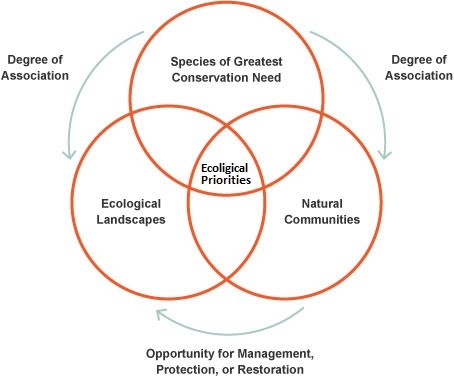Species of Greatest Conservation Need
Wisconsin Wildlife Action Plan
Species of Greatest Conservation Need (SGCN) have low and declining populations and need conservation action. They include invertebrates like insects, crayfish, snails and mussels, as well as birds, fish, mammals, reptiles and amphibians that are:
- listed as threatened or endangered;
- experiencing threats to their life history needs or habitats;
- few or low in abundance or distribution; or
- currently not rare but showing declines in abundance or habitat.
Identifying SGCN and species with information needs
Species experts assessed each species' rarity, threats and trends according to the SGCN selection flowchart, which relies on the NatureServe Conservation Status Assessment Methodology. Vulnerability to environmental change, status in Wisconsin relative to the rest of their range and genetic diversity were also assessed.
Species that did not have sufficient information or that did not meet the criteria for SGCN but were of concern to the experts were added to the Species with Information Needs (SINS) list. There are three categories of SINS, Basic, Ranking and Monitoring, organized around fundamentally different types of information needed. Their purpose is to help manage research and inventory objectives.
2015-2025 Species of Greatest Conservation Need (SGCN) List
2015-2025 Species with Information Needs List
SGCN, natural community and ecological landscape associations
Species of Greatest Conservation Need (SGCN) are associated with habitats (or natural communities) and places on the landscape. Understanding relationships among SGCN, natural communities and ecological landscapes help us decide on issues affecting SGCN and their habitat and how to respond. The WWAP scores these relationships in two ways:
- Species-ecological landscape associations (SGCN-EL score). Species distribution patterns are compared across Wisconsin's sixteen ecological landscapes, landform groups that share joint physical, biological, vegetation, geological, soil, water and climatic conditions. They can be used to identify the best areas of the state to manage for different natural communities, critical habitats and native plants and animals using an ecosystem management perspective. Species teams assign SGCN-EL scores based on knowledge of each species' current and historical populations.
- Species-natural community associations (SGCN-NC score). Species are assessed for their association with 108 natural community types. SGCN-EL associations reflect the geographic extent of a species. SGCN-NC associations reflect their ecological requirements. For example, some terrestrial snails highly associated with the Western Coulees and Ridges Ecological Landscape are only found on moist cliffs and algific talus slopes within this area. SGCN-NC association scores help identify issues and conservation actions, which often occur at a scale smaller than the ecological landscape and tell us which natural community(ies) are essential to restore, protect or manage for a species or group of species.
Conservation actions
Based on the most critical issues and threats affecting SGCN and their habitat over the next ten years, species experts identified priority conservation actions and effectiveness monitoring measures.
PLAN DOCUMENTS, ASSOCIATION SCORES AND COA MAPS
- WWAP 2015-2025 report, COA map, and dataset collection
- Rare species, communities and ecological landscape association scores


